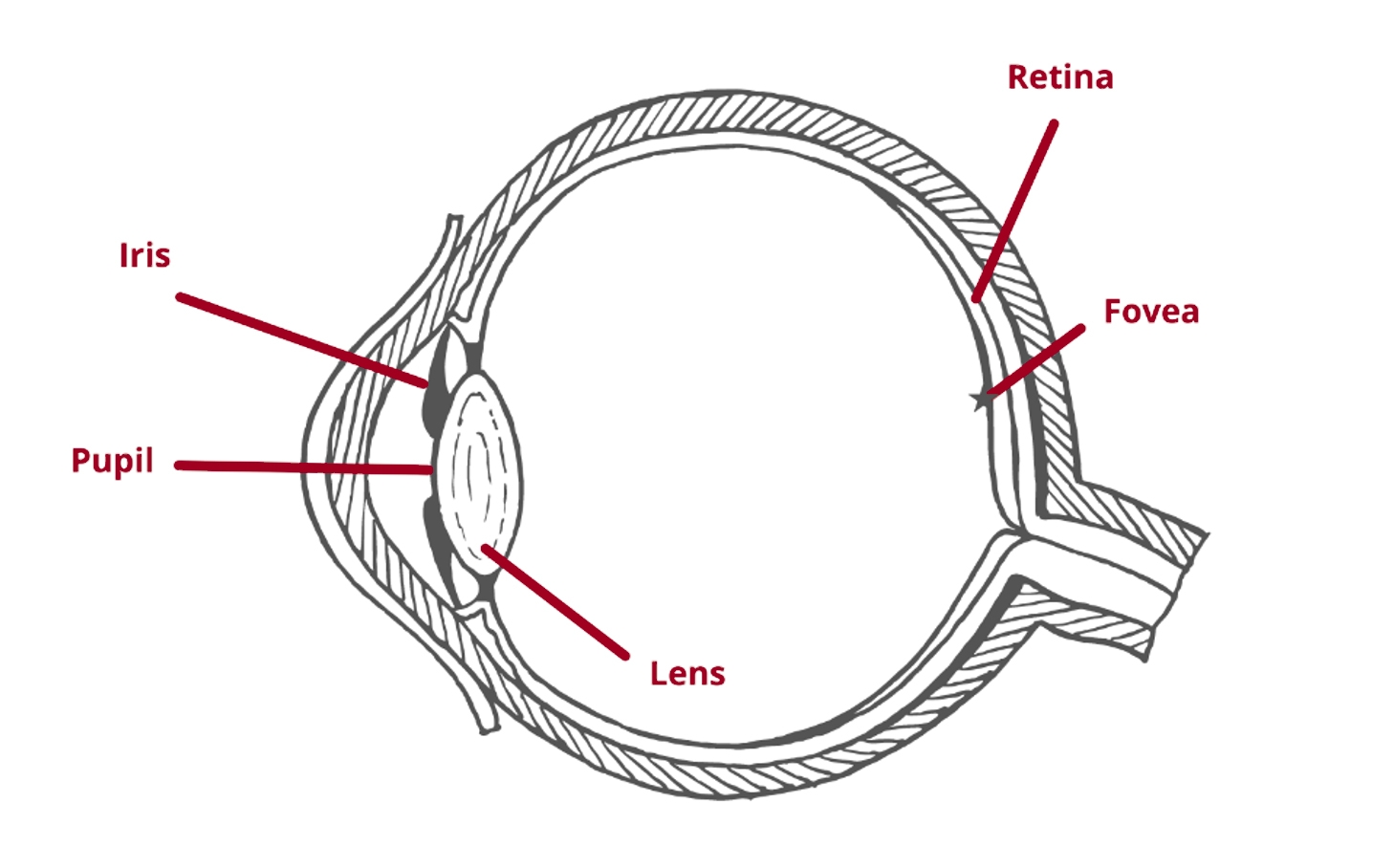23.02.2022
Facts about Fixations and Saccades
 by Mirta Mikac, Product Manager
by Mirta Mikac, Product Manager
Knowing the environment through fixations
One of the most efficient means of obtaining information from our surroundings is through eye fixations.¹ They occur when the gaze is maintained on a particular location, meaning that the central foveal vision is held in place to allow for the uptake of visual information. The acquired visual information is clear and detailed due to the fovea. The fovea is a small pit located in the center of the retina and is composed of packed cones (photoreceptor cells responsible for color vision). Fixations can be also referred to as events given their characteristics – the onset and offset time, and a variable duration based on which the eye tracking signal is often divided.² Fixation duration is also context-depended. For instance, shorter fixations are observed when reading a book, while longer fixations are detected when observing the scenery. Since the eye tracking signal is mostly focused on fixations, these eye movements are often visualized as circles whose size is proportional to the fixation duration – the longer the fixation, the bigger the circle.

Within the fields of experimental psychology and cognitive neuroscience, fixations are used as an indicator of visual attention and to make inferences about cognitive processes and states.³ In recent history, they have become an integral part of eye movement data in applied research fields like consumer behavior, where they are used for evaluating the allocation of attentional resources between stimuli.⁴ For instance, longer time to first fixation (TTFF) may imply a lower saliency of visual attractiveness power of the stimulus, while longer fixation duration may suggest either engaging stimulus or a greater effort to make sense of something.
Illustration of Fixations vs. Saccades

Saccades also reflect cognitive processing
Unlike fixations, saccades are rapid eye movements, meaning that the eyes voluntarily shift from one target to another. Such eye shift is generally occurring with the speed of up to 700 degrees/second within 30-100 ms in which the fovea is rapidly moved from one point of interest to another.⁵ Their amplitude is affected by the types of visual behavior where smaller saccadic movements are made while reading, and larger during gazing around the room.⁶ Two different groups of saccades can be also distinguished:⁷
- Initiated saccades without the visual target
- Performed saccades as a response to the visual stimuli
The main difference between these two types of saccades is in brain processing.⁸ The former saccade type can be observed with the memory-guided saccade (MGS) paradigm. In this task, subjects have to remember for a short period of time the location of the next visual target which they have to perform a saccade toward. The latter type can be elicited with the visually guided saccade (VGS) method in which the subjects first look at the central fixed target. Once the central target disappears, subjects move their eyes to another target that appears somewhere outside the center of their visual field.

To perform a saccade, various cortical regions work together. Depending on the type of saccade, this eye movement is either initiated in the frontal eye field (FEF) or in the parietal eye field (PEF), also known as the posterior parietal cortex (PPC).⁷ The reflexive or automatic saccades are initiated in the PEF, while the saccades which are the result of cognitively demanding eye movement tasks originate in the frontal lobe in the area of FEF. The signal is then sent from either PEF or FEF to the superior colliculus (SC), which forwards the next signals to the saccade generator in the brainstem. There, the saccade generator sends its output to the oculomotor nuclei where the neuronal activity of motor neurons activates the saccade.
When it comes to analyzing and understanding saccades in-depth, the oculo-metrics such as response time (latency), velocity, amplitude, duration, frequency response, and error rate are used.⁹ Even though no new information can be obtained with this eye movement, saccades are particularly important for understanding cognitive functions and neurodegenerative processes.
1
Russo, J.E. (1978). Eye Fixations Can Save the World: a Critical Evaluation and a Comparison Between Eye Fixations and Other Information Processing Methodologies. Advances in Consumer Research, 5, 561-570.
2
Hessels, R.S., Niehorster, D.C., Nyström, M., Andersson, R., & Hooge, I.T.C. (2018). Is the eye-movement field confused about fixations and saccades? A survey among 124 researchers. R. Soc. Open sci. 5:180502.
3
Liversedge, S.P., & Findlay, J.M. (2000). Saccadic eye movements and cognition. Trends Cogn Sci, 4, 6-14.
4
Bell. L., Vogt, J., Willemse, C., Routledge, T., Butler, L.T., & Sakaki, M. (2018). Beyond Self-Report: A Review of Physiological and Neuroscientific Methods to Investigate Consumer Behavior. Front. Psychol.
5
Goffart, L. (2009). Saccadic Eye Movements. Academic Press: Oxford, p.437-44.
6
Purves, D., & Williams, S.M. (2001). Neuroscience. 2nd edition. Sinauer Associates.
7
Terao, Y., Fukuda, H., & Hikosaka, O. (2017). What do eye movements tell us about patients with neurological disorders? – An introduction to saccade recording in the clinical setting. Proc Jpn Acad Ser B Phys Biol Sci., 93(10), 772-801
8
Imaoka, Y., Flury, A., & de Bruin, E.D. (2020). Assessing Saccadic Eye Movements With Head-Mounted Display Virtual Reality Technology. Front. Psychiatry. 11:572938.
9
Marandi, R.Z., & Gazerani, P. (2019). Aging and eye tracking: in the quest for objective biomarkers. Future Neurol, 14-22.
